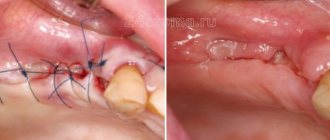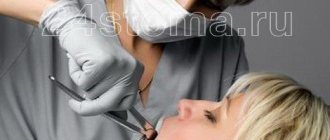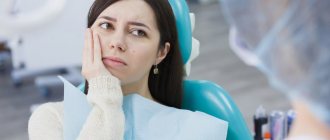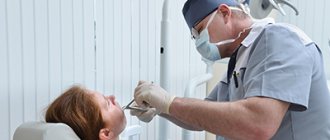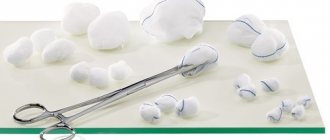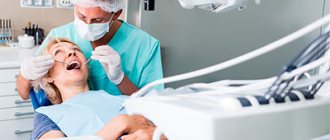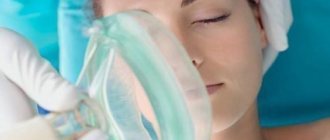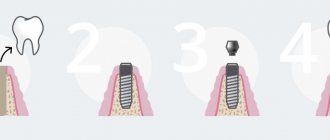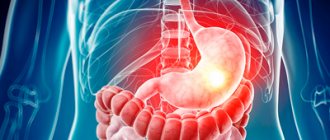Tooth extraction is a surgical intervention accompanied by a violation of tissue integrity. In other words, the dental surgeon is forced to injure the patient with the formation of a wound in the oral cavity. The human body is simply obliged to somehow react to such interference in order to protect itself. This occurs by releasing various substances into the blood that are responsible for pain, inflammation, and fever. In this way, the body gives a signal that a “breakdown” has occurred somewhere, and urgent action is needed.
The temperature after tooth extraction increases so that the pathogenic microflora dies. After all, it is the infection and its consequences that bring the patient to the surgeon. After extracting its main source, it does not completely disappear from the body. One way or another he gets into the wound. As a rule, by regulating the temperature, our body copes and prevents it from spreading and multiplying. But there are also more severe cases that require differential diagnosis, drug, surgical and/or therapeutic treatment.
Why does the temperature rise after tooth extraction?
The following pathological conditions are usually the reasons for surgical intervention:
- periodontitis with obstruction of root canals;
- complete tooth destruction;
- periodontitis, which causes mobility of the dentition;
- damage to the dental canal;
- abscess, phlegmon, etc.
These diseases themselves are inflammatory in nature and are associated with infection. Can body temperature rise after tooth extraction (hyperthermia) in this case? Of course yes. And this is not even a bad sign, but a normal sign, especially if it lasts a day or two. This means the patient’s immune system is working perfectly.
But there are other reasons for the appearance of hyperthermia. Perhaps part of the tooth remained in the socket, which caused such a violent reaction in the body. The resulting granuloma then develops into a cyst - the situation worsens. Fever may be associated with the development of alveolitis - inflammation of the socket, osteomyelitis as its consequence, damage to neighboring healthy tissues due to the carelessness of the doctor, suppuration in the socket due to the presence of a foreign body (tampon, for example). If a tooth in the upper jaw was removed, then the wall of the maxillary sinus may have been damaged, which led to inflammation in the corresponding area - sinusitis.
Professional help
Tooth extraction is always accompanied by an x-ray. It is necessary to obtain a complete picture of the location of the tooth and its parts, visualize cracks, cysts, correct location of the roots and crown, and interface with neighboring units.
Without an x-ray, the doctor works blindly and cannot determine the level of complexity of the procedure and all the necessary actions during the operation.
To minimize any consequences of tooth extraction or treatment, several precautions are always taken:
- Anesthesia.
- Removal of saliva.
- Disinfection of the operating surface.
- Suction of excess fluid from the wound.
- Repeated disinfection of the wound surface after removal.
- Stitching the edges of the wound if necessary.
- Recommendations for postoperative care.
All these points are very important. They activate the body’s healing abilities and allow intervention without infection.
What if I have a fever after wisdom tooth removal?
Figure 8 extraction requires complex removal. It involves cutting the periosteum to gain access to the root canal. At the end of the operation, the patient's gums are sutured. Only an oral and maxillofacial surgeon should work with 8.
Due to the complexity of the operation, the formation of a considerable wound, and the presence of sutures, the temperature often rises after the removal of a wisdom tooth. And the doctor should warn about this possible reaction. There is no need to be afraid. However, you should be attentive to the signals sent by the body.
One of the “side” effects of such an operation, which contributes to the fact that after the removal of a wisdom tooth the temperature reaches 38 degrees Celsius or more, is the formation of a hematoma. It is formed, as a rule, at the site of the removed figure eight. This is due to the weakness of the walls of small blood vessels or their damage during surgery. In the absence of adequate treatment, pus forms at the site of the hematoma. This condition requires urgent surgical intervention.
A child has a fever after dental treatment: what to do?
Sometimes after dental treatment, the child’s temperature rises, and the parents immediately panic. In fact, its increase may be explained by the fact that the baby was worried in the doctor’s office or by the body’s individual reactions to the intervention. If after a few hours the temperature drops on its own, there is no reason to worry. If it remains stable at high values, it is better to consult a doctor.
If you have the symptoms described in this article, be sure to make an appointment at our clinic.
Don't self-medicate! Even the smallest problem, if not treated correctly, can significantly complicate your life.
By contacting us, you can be sure that:
- Get high-quality and free consultation .
- You will receive the best prices for treatment and the opportunity to receive a special promotional price.
- Only modern equipment and materials will be used.
- You will be treated by professional doctors with many years of experience.
- We offer treatment on credit or in installments. There is also the possibility of obtaining a tax deduction.
- We work seven days a week and without a lunch break, from 9 a.m. to 10 p.m.
+7 (495) 132-02-96
Make an appointment
In what other cases does hyperthermia occur?
Is it possible that fever after tooth extraction is not associated with infection or tissue injury? Yes, this reaction of the body is sometimes caused by an allergy to anesthetics or other drugs used during the operation. The swelling that occurs at the injection site, for example, also helps to activate the body's defenses. It “seems” to him that the condition is critical and atypical, as it is characterized by the accumulation of a large amount of fluid in the tissues and increased pressure. Hyperthermia helps fight swelling.
For many, going to the surgeon is a stressful situation. It is accompanied by fear, discomfort, pain. The hyperthermic reaction is natural in this case. This is psychosomatics.
Hyperthermia that occurs after visiting a dental surgeon can be caused by an acute respiratory viral infection (ARVI). This is either a coincidence, or the operation simply weakened the body’s defenses, allowing viruses to “rule the roost.”
Reasons for the increase
Temperature is, first of all, a signal from the body that some changes are occurring, something has disrupted the usual course of life.
Several standard reasons for fever after visiting the dentist:
- Reaction to pain after the anesthetic wears off. Pain is always stressful for the body, and the body reacts to stress with apathy, bad mood, weakness, and fever.
- Immune response to a wound in the oral cavity. The mouth contains the maximum amount of bacteria, both beneficial and dangerous, and any wound can become a conductor of infection. By raising the temperature, the body fights infection. It kills all dangerous microbes so that the wound heals faster and does not pose a threat.
- Swelling after injection and removal. Swelling in the oral cavity is an atypical condition and is perceived by the body as dangerous. Too much fluid accumulates in cells and tissues, pressure rises, and the system begins to increase temperature to combat swelling.
- Lymph node reaction. Near the jaw there are cervical lymph nodes; they, like sensitive guards of the whole body, can respond to injuries to surrounding tissues by increasing and, as a result, raising the temperature.
- Psychosomatics. An increase in temperature can be a natural human reaction to stress, fear, and inconvenience. This is especially pronounced if the patient is afraid of dental procedures.
- Allergic reaction. Most often, patients are aware of this feature of the body.
All of the above reasons are completely natural. They mean that the body’s defenses are working, sending signals and dealing with the problems of the consequences of medical intervention.
In these cases, there is no need to see a doctor, everything goes away in a maximum of three days, and the value on the thermometer does not exceed 38.50.
However, there are also more complex and dangerous reasons for deterioration in health. This is a weakening of the immune system against the background of acute respiratory viral infections, influenza, and colds. The stress of tooth extraction can serve as an impetus for the accelerated development of the disease and you need to consult a therapist.
In this case, the pain will not be localized at the site of tooth extraction - this is the main reason to go to the clinic and not to the dentist.
Are fevers associated with tooth extraction dangerous for children?
Milk teeth also sometimes have to be removed, for example, if they interfere with the growth of permanent teeth or are too damaged and cannot be restored. Dental extraction in children is also a surgical procedure. However, we are usually talking here about a simple removal, in which the doctor separates the gum from the crown and removes the latter with forceps. A wound is formed, but it is small. Temporary teeth, as a rule, do not hold tightly, so their extraction is almost bloodless and painless.
If, after tooth extraction, the child’s temperature is 37 degrees or more, then this is not the norm. If you have this symptom, you should definitely consult a doctor (dentist, pediatrician).
Normal and critical values
You should focus on the thermometer reading at 380C. Time frame - from 1 to 3 days. If the temperature does not exceed this threshold, the body fights successfully and will cope with all the problems itself.
You should definitely consult a doctor if you experience accompanying changes:
- Edema. The appearance of new or intensifying postoperative symptoms.
- Increasing pain.
- The appearance of new foci of unpleasant or painful sensations.
- Sore throat, runny nose, difficulty breathing.
- The temperature lasts more than three days or rises.
The critical threshold for calling an ambulance or immediately going to the dentist will be a temperature rise above 39.20C.
In addition, the temperature may be accompanied by other symptoms - a sharp increase in pain, opening of the socket and bleeding, purulent discharge from the socket, cutting pain with increasing swelling, difficulty breathing and signs of loss of strength, muscle weakness, increased pulse and heartbeat to noticeable levels.
How long does the temperature last after tooth extraction?
A normal indicator of the thermal state of the human body is considered to be in the range of 35.5–37.0 degrees Celsius. If after tooth extraction the temperature remains between 37–38 degrees (it is also called low-grade fever), then there is nothing terrible about it. Everything should return to normal in 1–3 days. If the thermometer shows 38–39 degrees, this may indicate complications. The body gives an SOS signal. You should consult a doctor.
A value of 39.2 degrees is considered critical. In this case, you need to call an ambulance.
Any hyperthermic reaction lasting more than 3 days is a good reason to consult a doctor. This is especially true when, in addition to an increase in the thermal state indicator, there are other alarming symptoms.
Removing 2 wisdom teeth at the same time
Removal of two wisdom teeth from one side of the jaw. Pros and cons of this approach.
Two teeth at once on one side is a very good technique. In this case, we immediately remove two teeth and the healing process takes place only once. Accordingly, the pain also disappears once. The healing is in no way burdened by the fact that we remove two of them at once. It’s a good, even excellent approach, and that’s what we do in most cases if the patient doesn’t mind.
An example of removing two wisdom teeth at once - HERE
How to help yourself at home with a hyperthermic reaction?
If a person has a fever, then he needs:
- drinking plenty of water;
- cool room (no higher than 25 degrees);
- minimum amount of clothing (no wrappings, blankets, etc.);
- fresh air (room ventilation).
Antipyretics can be given if the temperature is 38 or more after tooth extraction. Preference should be given to drugs based on paracetamol and/or ibuprofen. In pharmacies they are sold under different trade names, for example, Efferalgan, Panadol, Nurofen, Mig-400, Next, Ibuklin, etc. The patient should be given medicine only if a symptom is present. They are not used to prevent fever.
If the patient is a child, then before contacting a doctor, you can give a dose of an antipyretic drug in the form of a suspension, syrup, or soluble tablet, according to the instructions for the drug. Dosage forms for adults (not according to age) cannot be used (half a tablet, for example, or one fourth). It is important to use rectal antipyretic suppositories at night or during daytime sleep.
Both adults and children should not be given medications containing metamizole sodium (Analgin) and acetylsalicylic acid (Aspirin) to reduce body temperature. Can cause bleeding, agranulocytosis, electrolyte disturbances, etc.
ethnoscience
Folk antipyretics are popular because of their simplicity and accessibility. Often they are no less effective than drug treatment, or successfully complement it:
- Drink plenty of fluids. Unsweetened drinks at room temperature. Fruit drinks, weak tea, homemade dried fruit compotes, clean and mineral water. Drinking plenty of fluids removes toxins from the body and helps the body rehydrate after sweating. Sweet sodas, cold drinks, and alcoholic drinks are strictly contraindicated.
- Cold compresses. Cold compresses are applied to the forehead and changed periodically as the tissue is heated.
- Nutrition. If the body does not want to eat, there is no need to force feed it. Fasting when the temperature rises is therapeutic in nature, as the body devotes all its strength to destroying the disease, without being distracted by digesting food. Vitamin compotes and light cereals contain enough nutrients, so a small amount of light food and plenty of fluids will be ideal.
- Enema. Using a chamomile or soda solution will help get rid of temperature constipation; the procedure will remove toxins and make it easier for the body to fight the disease.
- Cloth. Cotton and other materials that absorb moisture well. You can't wrap yourself up. The most effective way is to undress completely and allow sweating to occur freely.
- Room. A hot, stuffy room needs to be ventilated, while avoiding drafts. That is, it is better for the patient to leave the room for ventilation. The optimal room temperature is 250C. It feels cool; in this case, the patient can be covered with a light cotton blanket, but not warmed.
- Rubdowns. Constantly wiping your entire body with a cool, wet cloth is a good way to lower your temperature. You can use water at room temperature, but it is worth remembering that it will also seem very cold to the patient.
When is it absolutely impossible to do without a doctor?
If the thermometer shows more than 38 degrees, and in addition to this, the following symptoms are present, you should immediately consult a doctor:
- increasing pain;
- swelling and redness of the gums;
- swelling in the cheek area;
- enlarged and painful lymph nodes;
- the presence of pus at the removal site;
- Nauseous odor from the mouth.
The doctor will conduct instrumental diagnostics, examination and make a diagnosis. If the problem can be solved surgically, then he will clean the wound from pus, remove the remainder of the tooth/root/foreign object, and suture the edges of the wound if necessary. As after the removal of a wisdom tooth, a temperature of 37 may appear again. However, this will already be a normal reaction to surgery.
If necessary, the doctor may prescribe anti-inflammatory drugs in a course, for example, for 5-10 days. Often in such cases, Nise or Nimesil, Panoxen or Diclofenac with Paracetamol, etc. are prescribed. Also, surgical complications sometimes require the use of antibacterial agents, for example, from a number of fluoroquinolones (Ofloxacin, Tsiprolet A), penicillins (Amoxicillin, Augmentin), sulfonamides (Sulfadimizine, Sulfadimethoxine ). All of these drugs require a prescription.
Antipyretic drugs
Reducing the temperature with the help of medications is only worthwhile to help the body fight infection, that is, after exceeding the threshold value of 380C.
- Paracetamol.
- Ibuprofen.
- Nimesil.
- Nurofen.
- Aspirin.
- Rinza.
Analgin is a pain reliever that is often recommended against fever . Side effects include agranulocytosis (decreased number of white blood cells), electrolyte disorders, and oliguria. Therefore, adults should not take it at a fever, and children are strictly prohibited.
All medications must be taken exactly in accordance with the instructions for use, carefully studying the contraindications, observing the prescribed periods, not exceeding the age-appropriate dosage, then the treatment will be most effective and there will be no chance of side effects.
In emergency cases, you can give an injection of a lytic mixture (2 ml of analgin + 2 ml of diphenhydramine) - these are the injections that the ambulance uses.
Therefore, if you do not have the necessary medications at home or in the pharmacy, and the temperature exceeds 390C and the condition is close to critical, you need to call an ambulance.
Let's figure out whether it is painful to remove a wisdom tooth from below, and what it depends on. In this publication, read reviews about tooth extraction under general anesthesia.
Here https://dr-zubov.ru/xirurgiya/udalenie-zubov/chto-delat-mudrosti-rastet-v-shheku.html all the subtleties of removing a wisdom tooth that grows into the cheek.
How to prevent the temperature from rising?
Prevention of a hyperthermic reaction consists of:
- antiseptic treatment of the oral cavity after surgery (it is recommended to make baths/lotions using the drugs Miramistin, Chlorhexidine, Iodinol, Betadine);
- regular hygiene procedures (brushing your teeth twice a day, rinsing your mouth after eating);
- refusal to visit public places for swimming (beach, water park, sauna, bathhouse) and sunbathing;
- careful choice of food (it is better not to eat solid food in the first days);
- alcohol taboo.
If other preventive measures have been prescribed by the doctor, these must also be followed strictly.
What is the role of the clinic in the prevention of hyperthermic conditions?
The specialist, the way he carried out the work and gave explanations to the patient, is the most important component of success in the postoperative period. Hyperthermia will not bother a person who has undergone surgery if it was carried out according to the protocol, under sterile conditions, using the latest technologies. In the clinic “Practice of Doctor Sklyaruk” everything is exactly like this, so our patients receive practically no complaints about an increase in temperature after tooth extraction.
If you value your health and don’t want to waste time on repeated forced visits to the doctor, then trust the specialists of our dentistry. We work neatly, cleanly and professionally. Appointments can be made by calling the phone number listed on the website. You can also order a call back by leaving your number online.
Tooth cyst (radicular cyst) - symptoms and treatment
Types of treatment for radicular cysts can be divided into conservative, surgical and conservative-surgical.
Conservative treatment
The conservative method is aimed at removing the necrotic neurovascular bundle of the tooth (pulp) and eliminating pathological changes in the bone behind the root apex.
The decayed pulp is removed with special endodontic instruments. Then the root canal is expanded and antiseptic treatment is carried out. Medicinal pastes are introduced into the root canal, which eliminate the microbial flora and restore the affected bone tissue. These pastes are administered for a period from several days to 1–1.5 months. Usually this process is well tolerated, but sometimes the pastes cause an exacerbation of the process with severe pain. To prevent the paste from getting into the mouth, the tooth cavity is hermetically sealed with a temporary filling.
If the inflammation of the bone tissue is eliminated, the root canals are filled with permanent material, and the defect in the hard tissues of the tooth is closed with a filling.
The fact is that there are no microorganisms in the cyst cavity itself. This is a response to a high concentration of microorganisms in infected root canals. After proper treatment of the canals, the number of microbes decreases and the body, with the help of cellular immunity, copes with a small number of microorganisms in the area of the root apex. The “barrier” in the form of a thin connective tissue membrane of the cyst becomes unnecessary, and macrophages completely destroy the membrane. With a small size of the cyst, rational treatment and the body’s ability to resist the disease, conservative treatment gives a good result - the shell of the radicular cyst is completely resorbed, the alveolar fascicle bone is restored.
After final treatment of the canals, it is recommended to do a CT scan after 6 and 12 months. If the cyst is completely resolved, there is no need to fear relapses, since the cause (bacterial infection of the canals) has been completely eliminated.
After root canal treatment, the tooth does not receive adequate nutrition, so it may deteriorate over time. To prevent this, it is recommended to cover pulpless teeth with artificial crowns.
If the conservative method is ineffective and the focus of destruction remains, surgical removal of the cyst is performed. This combination of methods is called conservative-surgical treatment.
Surgery
The surgical method involves removing a cyst from a previously pulpless tooth, and often the apex of the tooth root is cut off. The operation is carried out strictly according to indications: in case of a broken instrument, poor-quality treatment of the measles canal, or if the root protrudes into the cavity of the cyst. The extent of surgical intervention is determined during diagnosis.
To improve the prognosis after surgical treatment, bone defects are more often replaced with osteoplastic materials [15][16]. Such materials restore lost bone tissue and stimulate the formation of new one.
One of the main directions in modern reconstructive surgery is the use of biotechnologies, which allow accelerating the processes of regeneration of damaged tissues [17]. We are talking about platelet-derived growth factors obtained from the patient’s own blood. First, venous blood is taken from the patient. Then, using a centrifuge, the blood is separated into fractions. The platelet-rich fraction is used to restore bone tissue defects. This method is available almost everywhere.
There are two main surgical methods for treating radicular cysts: cystectomy and cystotomy.
1. Cystectomy is an operation in which the fibrous membrane of the cyst is completely removed. Usually performed in an outpatient setting under local anesthesia. If the cyst is large and affects the nasal cavity, maxillary sinus or mandibular canal, the operation is performed in a maxillofacial surgery hospital.
Surgical technique:
- Under local or general anesthesia, a section of the jaw bone in the projection of the cyst is skeletonized (exposed).
- Access to the cyst cavity is created, all affected bone tissue and the cyst shell are removed.
- According to indications, the root apex or part of it is cut off and retrograde filling of the root canal is performed (filling through the root apex) and filling of the apical openings of the canals with special cement intended for these purposes.
- The surgical wound is treated with antiseptic solutions, filled with osteoplastic material and sutured.
- Postoperative material is sent for pathohistological examination.
A dental microscope is used for treatment. It allows you to minimize the volume of removal of the root apex and effectively close the root canals.
You must visit the doctor the next day after the operation, then if the course is calm after 10–14 days, to remove the stitches. The patient should be under the supervision of the attending physician until the postoperative wound is completely healed, then return every six months to monitor the restoration of bone tissue and exclude relapse. As practice shows, relapses are rare; they are usually detected in the first year after surgery.
Types of material for filling a bone tissue defect after surgery:
- Autogenous material is obtained from another area of the patient’s bone tissue (branch of the jaw, chin, etc.). Due to its complete biological compatibility, such material is rarely rejected and quickly restores the defect. However, when the patient’s tissue is taken, the operation time increases, the intervention becomes more traumatic, which negatively affects the patient’s recovery.
- Xenogeneic material is obtained after special processing of mammalian bone tissue. The most commonly used bones are ox and pork. Processing removes substances that can cause immune and allergic reactions.
- The synthetic material contains calcium salts. For better compatibility it is often used in combination with autogenous material.
2. Cystotomy is an operation during which the cyst shell is not removed, but only its anterior wall is excised, which allows the contents of the cyst to be evacuated. With cystotomy, the scope of surgical intervention is smaller, but recovery after such an operation lasts longer (about a month). The resulting bone defect is filled with turunda with iodoform, then dressings are made with a certain frequency, replacing the turunda. This method is used less and less due to protracted recovery, the introduction of new techniques and the improvement of the material and technical base.
Oronasal (between the mouth and nose) cystectomy and oronasal cystotomy are performed if the cyst penetrates into the maxillary sinus or pushes it aside.
Surgical methods using laser technology are increasingly used in modern dentistry. Laser techniques are less traumatic. In addition, the laser has a bactericidal property, which reduces the likelihood of developing purulent-inflammatory complications [18][19][20].
Removal of a tooth. A tooth is removed only if saving it is not practical. Indications for removal:
- complete destruction of the crown part of the tooth;
- destruction of the hard tissues of the tooth below the level of the gingival margin by more than 2 mm, when it is not possible to advance the root orthodontically or when the root of the tooth is too short, which will complicate further prosthetics;
- lack of lumen in the root canal (due to structural features or previous treatment).
In all other cases, tooth-preserving operations described above are performed.
Complications after treatment
Complications after cyst removal occur infrequently. These include perforation of the maxillary sinus, damage to the inferior alveolar nerve, as well as the formation of a residual cyst, which is formed during incomplete excision of the radicular cyst.
